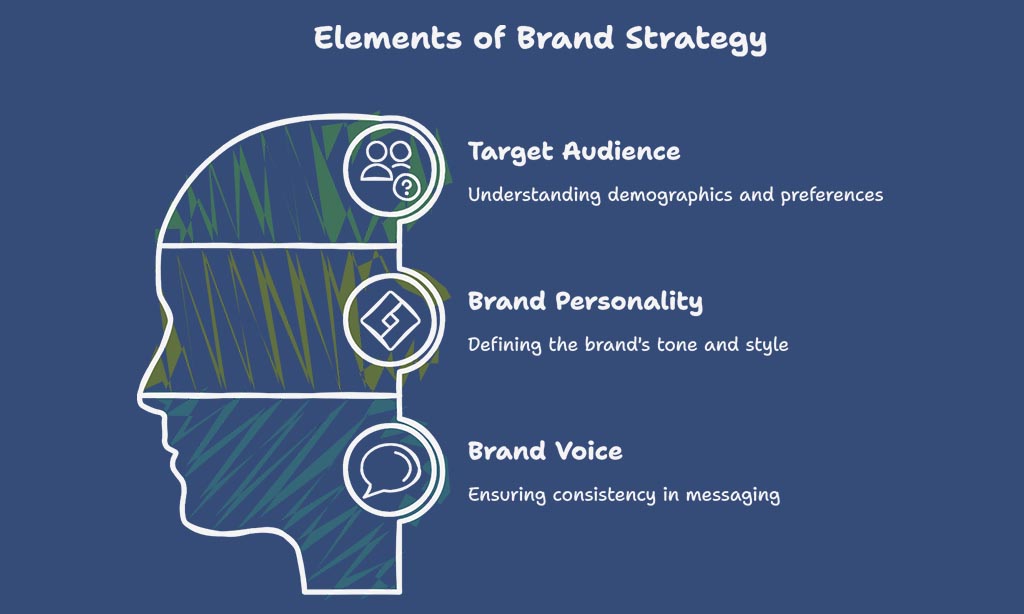Selecting the perfect domain name is one of the most critical decisions for any online business. Your domain name shapes your digital identity, influences your brand perception, impacts SEO rankings, and ultimately drives traffic and conversions.
A memorable, strategic domain helps your audience find and remember your business effortlessly. This detailed guide walks you through 10 essential steps, equipping you with actionable insights, practical examples, and the latest trends to ensure your domain name effectively supports your business growth and online visibility.
Step 1: Define Your Brand Clearly
Establishing your brand clearly sets the foundation for choosing a domain name. A clearly defined brand helps you communicate your business purpose directly and succinctly to your customers.
This involves understanding your target audience deeply, identifying your brand personality, and maintaining a consistent brand voice across all communication platforms. An effectively defined brand guides domain name selection, ensuring alignment with your business objectives. This approach significantly enhances audience recognition and trust.
Key Points to Consider:
- Target audience: Understand their needs, preferences, and language style.
- Brand personality: Is your brand professional, playful, innovative, or classic?
- Brand voice: Consistency in messaging across platforms.
| Brand Aspect | Key Considerations |
| Target Audience | Age, location, interests, language |
| Personality | Tone, visuals, style |
| Brand Voice | Formality, casualness, consistency |
Case Study: Nike’s domain name clearly resonates with their bold, energetic brand identity, instantly recognizable globally.
Step 2: Prioritize Simplicity and Memorability
An effective domain is simple, memorable, and easily shareable. Avoid overly complex names that are difficult to remember or type. A concise domain significantly improves recall among users, encourages word-of-mouth marketing, and minimizes typing errors or confusion.
Prioritizing simplicity ensures your domain resonates quickly with your audience, helping you achieve greater visibility and engagement. Keep your domain clear, catchy, and relevant to your business for maximum impact.
Quick Checklist:
- Short (ideally under 15 characters)
- Easy to pronounce
- Avoid confusing spellings
| Good Domain Examples | Poor Domain Examples |
| Apple.com | Best4U-OnlineDeals123.net |
| Amazon.com | Shop4CheapGoods.xyz |
Step 3: Use Relevant Keywords Wisely
Keywords in domains can boost SEO, but careful selection is crucial. Select one or two strategic keywords relevant to your niche.
Relevant keywords enhance domain clarity, making your business instantly understandable to both users and search engines. However, avoid keyword stuffing; instead, choose keywords that align naturally with your core business. Effective keyword use can significantly boost your visibility in search results, driving more organic traffic to your site.
Keyword Integration Tips:
- Primary keyword related to your main product/service
- Secondary semantic keywords enhancing relevance
| Industry | Primary Keyword Examples | Secondary Semantic Keywords |
| Travel | Travel, Tour | Trip, Journey, Adventure |
| Fitness | Fitness, Gym | Workout, Training, Health |
Step 4: Opt for the Ideal Domain Extension
Choosing the right domain extension (.com, .org, .io, etc.) impacts credibility and search rankings. Your domain extension should clearly reflect the nature of your business and industry, thereby boosting user confidence.
Selecting an appropriate domain extension supports both branding objectives and SEO efforts, enhancing visibility. Carefully evaluating different extensions ensures your domain is not only professional but also highly relevant and trustworthy.
Best Domain Extensions for Different Businesses:
| Business Type | Recommended Extension | Reason |
| General Business | .com | Widely recognized and trusted |
| Non-Profit | .org | Instantly conveys organizational type |
| Tech Startups | .io, .tech | Innovative, tech-savvy perception |
| Local Businesses | .co.uk, .us | Local SEO boost |
Step 5: Avoid Numbers and Hyphens
Domains with numbers or hyphens can confuse visitors and appear less professional. Numbers and hyphens complicate verbal communication, increasing the chance of errors during domain sharing. They also tend to reduce perceived credibility, potentially affecting trust among visitors.
Domains without such complexities are easier to remember, type accurately, and promote organically. Prioritize domains that are straightforward and clear for optimal business performance.
Why Avoid Numbers and Hyphens?
- Easily misunderstood verbally
- Lower perceived credibility
- Often mistyped or forgotten
| Example Domain | Issue | Better Alternative |
| Cakes-4-you.com | Misunderstood verbally | CakesForYou.com |
| Best-Tech-1.net | Hard to remember accurately | BestTechOnline.net |
Step 6: Ensure Domain Name Availability and Trademark Check
Checking availability and trademarks helps prevent legal issues and branding conflicts. Conducting thorough research ensures your chosen domain is unique and legally safe, protecting your brand reputation.
Utilize domain availability tools and trademark databases to quickly confirm the domain’s status. This proactive approach safeguards your investment, ensuring uninterrupted brand building and minimizing potential legal complications.
Recommended Tools:
| Tool | Purpose | Benefits |
| GoDaddy Domain Checker | Domain availability check | Quick, user-friendly interface |
| Namecheap Domain Search | Domain availability | Competitive pricing |
| USPTO Trademark Database | Trademark verification | Legal compliance |
Example: Facebook’s acquisition of FB.com was part of its strategy to secure brand-related domains.
Step 7: Consider Future Scalability
Choosing a scalable domain is essential for long-term growth. Anticipating future business expansions, product launches, and geographic reach helps you select a versatile domain name. Avoid overly specific domains that might restrict growth potential, opting instead for broadly applicable ones.
Scalable domains effectively adapt to changing business conditions, ensuring sustained brand relevance and strength in evolving markets.
Key Questions to Ask:
- Can the domain adapt to new products or services?
- Does it support international expansion?
- Will it remain relevant long-term?
| Domain | Scalability Level | Reason |
| Amazon.com | High | Not limited to books; broadly open |
| BookStoreOnline.co | Low | Specifically limited to books |
Step 8: Conduct Audience Feedback and Testing
Getting real feedback from your target audience can validate your domain name choice and prevent poor decisions. This step helps you identify how your name sounds to others, whether it’s memorable, trustworthy, or even confusing.
By collecting responses from potential users, you can gain insights into how your domain will perform in real-world situations. It also gives you the chance to tweak or pivot if needed before you fully commit to marketing your brand. Feedback ensures your domain aligns with user expectations and drives better engagement.
Methods to Get Feedback:
- Online surveys
- Social media polls
- Focus groups
| Method | Benefits | Limitations |
| Online Surveys | Large sample size, quick | Less detailed feedback |
| Social media polls | High engagement, informal | Less representative sampling |
| Direct Interviews | Deep insights, accurate data | Time-consuming, costly |
Step 9: Think Globally, Act Locally
Your domain should reflect the geographic scope of your business. Whether you’re operating locally or targeting a global market, the domain name should support that mission. For international appeal, choose a domain that’s easily understandable across cultures and languages. If your focus is on local customers, a country-specific domain can improve regional trust and SEO.
Balancing global potential with local relevance helps your domain perform well in diverse markets and reach the right audience effectively.
Global vs. Local Domain Checklist:
| Aspect | Global Business Domain | Local Business Domain |
| Extension Choice | .com, .net | Country-specific |
| Language | Universal | Local dialect/language |
| SEO Strategy | Broad keywords | Specific local SEO |
Example: Airbnb uses .com globally but maintains local language versions to appeal to regional audiences.
Step 10: Register and Secure Your Chosen Domain Quickly
Domain names are claimed fast, and the perfect one may not remain available for long. Once you find a domain that fits all your business criteria, act quickly to register it before someone else does.
Securing your domain protects your brand and prevents costly disputes in the future. It’s also advisable to register multiple variations and TLDs related to your domain name.
This proactive step strengthens your brand’s online presence and prevents cyber-squatters from taking similar names.
Steps to Secure Your Domain:
- Choose reputable registrars
- Opt for privacy protection
- Register multiple domain variants/extensions
| Action | Importance |
| Immediate Registration | Prevent domain squatting |
| Privacy Protection | Avoid spam and protect identity |
| Multiple Domain Registration | Secure branding, avoid confusion |
Takeaways
By meticulously following these 10 essential steps, you can confidently select a domain name that not only reflects your brand identity but also enhances your online visibility and supports long-term business growth. Act promptly to secure the ideal domain name, laying a strong foundation for lasting business success.
A well-thought-out domain name reinforces brand consistency, improves search engine rankings, and builds audience trust. As your business evolves, your domain name remains a key asset in maintaining your digital footprint.
Start with the right domain today to future-proof your brand’s presence for years to come.












































